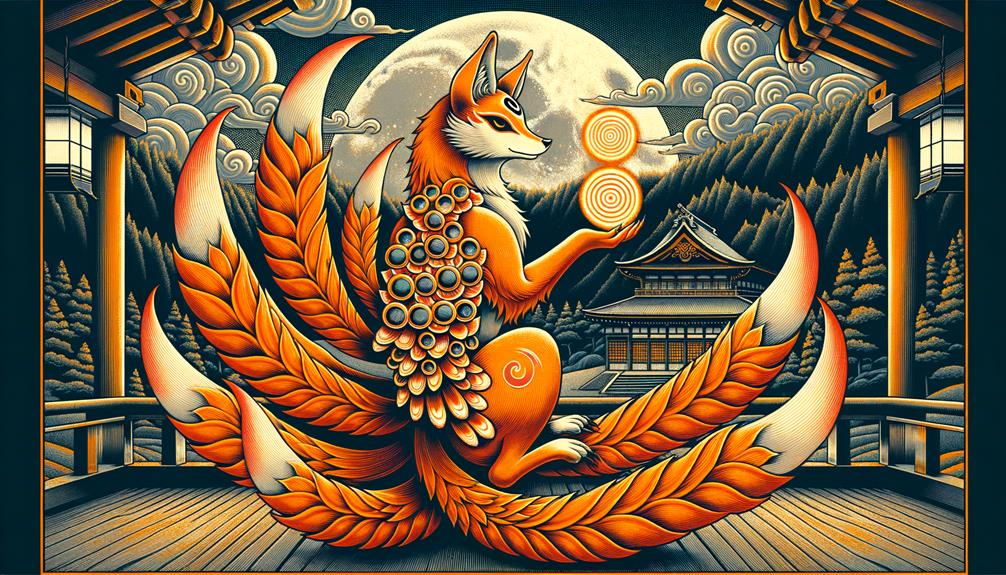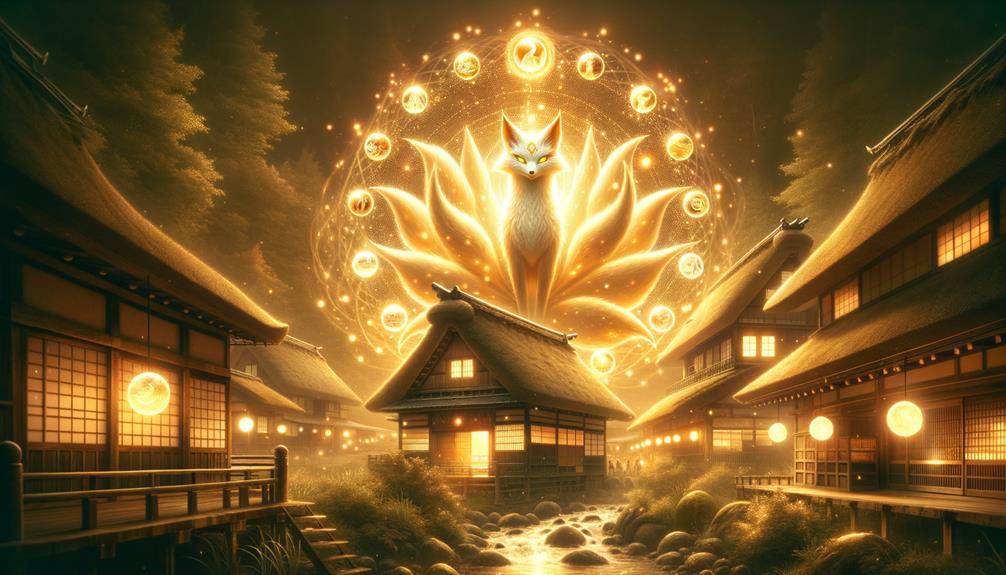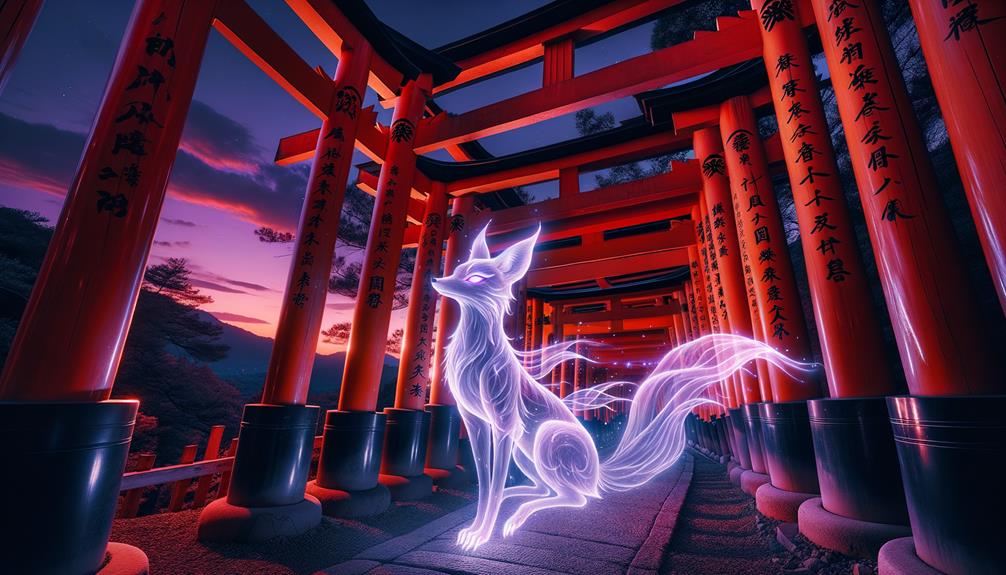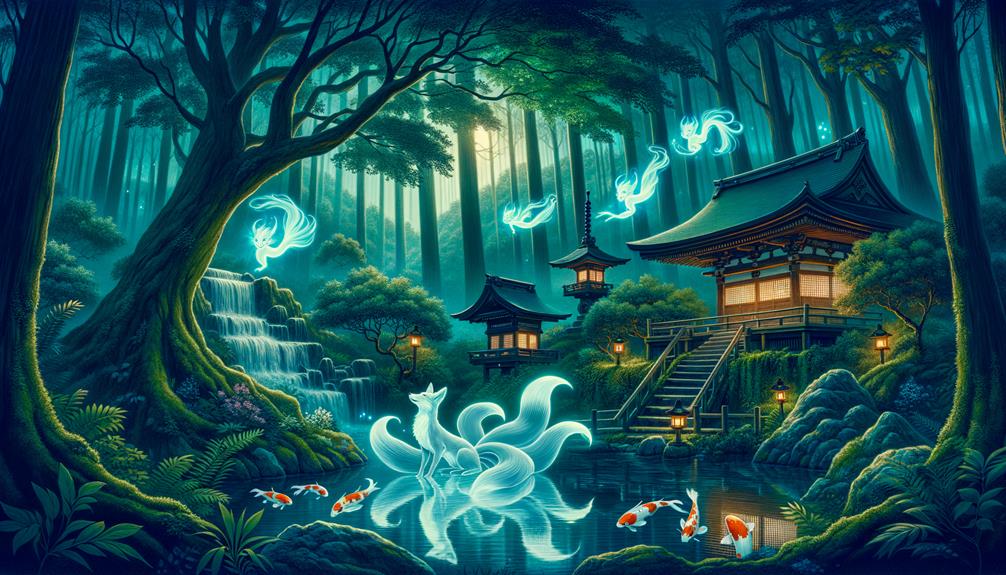Foxes have a firm place in the folklore of many cultures, but they are most prominent in the Kitsune myths of Japan. I've spent a good chunk of my life immersed in the study of these elusive beings, captivated by their ability to change form and their dual role as pranksters and guardians. Often, Kitsune are seen as underlings to Inari, a Shintō god, carrying out duties as go-betweens for the human and divine worlds. Their stories have been handed down through the ages, showing up in everything from ancient manuscripts to today's manga. However, despite the Kitsune's widespread cultural presence, there's a lot about these mysterious creatures that we still don't know. So, let's set out on a journey to dig deeper into the fascinating world of Kitsune mythology.
Understanding Kitsune in Japanese Folklore

If we take a look at Japanese folklore, we'll come across Kitsune, crafty foxes that are known for their supernatural abilities and their exceptional skill in changing their shapes. These foxes hold a vital role in the Shintō religion, serving as messengers and connecting the earthly and heavenly worlds. Often linked with Inari, the god of rice, these fox spirits are respected figures that showcase both good and evil traits.
During the historic Edo era, tales about Kitsune became wide-spread, and they became a significant part of Japan's cultural heritage. They are often portrayed as having the power to transform into humans, particularly attractive women, to engage with devout humans, making them even more mysterious. One popular story highlights the Nine-Tailed Fox, an influential Kitsune, whose multiple tails represent its age and wisdom.
Nowadays, the Kitsune's impact continues in Japanese pop culture. They are frequently featured in anime, manga, and literature, proving their lasting allure. These enchanting yokai (ghosts) vary from being protective spirits to playful tricksters, giving them a complex personality that makes them an intriguing subject in Japanese folklore.
The Symbolism of Kitsune Figures

Let's dive into the world of Kitsune figures. Their symbolism is rich, like a beautifully woven tapestry. It's a mix of good harvests, fertility, prosperity, and sly intelligence, all represented by these legendary creatures. In Japan, the Kitsune Fox is more than just an animal – it's a symbol that strikes a chord in the hearts of the people.
Kitsune are often found in connection with Inari, the Shinto god of rice. You'll see them frequently at Inari Shrines, where they're respected as messengers. There's one type of fox, the white or nine-tailed kitsune, that's especially revered. People believe it has extraordinary wisdom and power. When you see a kitsune depicted with a certain number of tails, that's showing how powerful it is. The nine-tailed kitsune is the strongest of them all.
The cultural myths around kitsune are fascinating in their contrasts. Yes, kitsune symbolize good things, but they're also known for their darker side – their knack for trickery and mischief. This dual nature serves as a metaphor for life's complexities, embodied in the Kitsune Fox in Japanese folklore.
Getting to know the symbolism of Kitsune figures helps us understand how the Fox in Japanese culture represents different aspects of life, prosperity, and wisdom. The influence of the kitsune is not confined to myths. It's also found in art, literature, and deep within the structure of Japanese society.
Manifestations of Kitsune in Folklore

Folklore is full of stories about Kitsune, enchanting trickster foxes with magical powers. These foxes are thought to be the embodiment of Shinto spirits or kami and are seen as critical links between our world and the heavens. It's often said that they have an impressive lifespan of up to 68 human years.
Japanese myths are full of tales about Kitsune, who are often depicted as shapeshifters and known for their intelligence and quick thinking. They are usually shown as protectors, spreaders of good fortune, and even as romantic partners. In the history of Japan, particularly during the Edo period, these foxes played a significant role in storytelling, representing societal norms and values.
Kitsune are generally associated with the deity Inari. The Zenko Kitsune are specifically seen as Inari's messengers and are seen as kind and beneficial, spreading good luck and protection. On the other hand, the Nogitsune are seen as playful fox spirits who cause trouble and bad luck. This contrast in their portrayal showcases the intricate moral lessons of Japanese folklore, where good and evil are often intertwined.
Nowadays, Kitsune still have a strong influence in Japanese pop culture, appearing in anime and manga. Their ongoing popularity is a testament to the depth and richness of these legendary foxes.
Notable Kitsune in Literature and Art

Kitsune, the legendary foxes of Japanese folklore, are deeply rooted in the country's cultural and historical narrative. These enigmatic creatures pop up in many forms throughout Japanese literature and art, leaving an unmistakable imprint from traditional theater right up to contemporary aesthetics.
Take, for example, the classic Japanese story, 'Tokutaro Was Deluded'. This tale from the Edo period showcases the classic Kitsune, full of cunning and mischief.
Kitsune continue to be relevant in present-day media. The TV series 'Teen Wolf' features a Kitsune character, shedding light on the more ominous side of Kitsune mythology. On the other hand, the manga series 'Grateful Foxes' offers a kinder perspective, depicting Kitsune as charitable beings.
In the visual arts, there's no better example of Kitsune's enduring cultural importance than the Fushimi Inari Shrine on Inari Mountain in Kyoto. The path to the shrine is lined with countless fox statues, each one a testament to the lasting significance of Kitsune in Japanese culture.
Here's a snapshot of notable Kitsune references:
| Notable Kitsune in Literature | Notable Kitsune in Art |
|---|---|
| 'Tokutaro Was Deluded' | Fushimi Inari Shrine |
| 'Teen Wolf' TV Series | Inari Mountain in Kyoto |
| 'Grateful Foxes' Manga Series | Numerous fox statues |
In essence, Kitsune are more than just characters or symbols – they're a fascinating part of Japan's cultural fabric.
Visiting Kitsune Landmarks in Japan

If you're drawn towards the complex and fascinating world of Kitsune mythology, then you should definitely plan a visit to Japan's famous Fushimi Inari Taisha shrine. Here, you can personally experience the ongoing cultural value of these mysterious creatures. The shrine, a key element of Japan's religious and cultural past, brings the legends of kitsune to life and traces its roots back to ancient Japan.
When you step foot in Japan, it feels like stepping into a realm where the mystical and the mundane seamlessly blend. Kitsune, a recurring figure in Japanese folklore, are portrayed as potent and magical entities. They're reputed for enchanting influential figures, with their allure and illusions, reaffirming their cultural prominence. This was especially noticeable during the Edo period when tales of Kitsune were common.
It's crucial to remember that while touring Kitsune landmarks in Japan, their impact isn't confined to historical locations. Kitsune have a significant presence in Japanese pop culture, shaping everything from cartoons to novels. Although their existence is deeply rooted in old customs, their portrayal continues to change, making them an intriguing part of Japan's cultural tapestry. Therefore, a visit to these landmarks is more than a simple historical expedition; it's an investigation into the persistent relevance of Kitsune mythology in modern-day Japan.
Frequently Asked Questions
What Is the Cultural Significance of Kitsune?
In my perspective, kitsune carry deep cultural weight, acting as symbols of good fortune and wealth. They are intricately linked to the spiritual beliefs in Japan and are seen as divine messengers. Additionally, they represent the sly trickster character in traditional tales and contemporary pop culture.
What Is a Kitsune in Chinese Mythology?
Ever wondered about the kitsune in Chinese mythology? Well, it's simply another name for the huli jing – a fox spirit that's quite well-known. These creatures are famous for their slyness and smarts, and their impressive ability to transform, often taking on human appearances. This mirrors the characteristics of their counterparts in Japanese mythology.
What Is the Japanese Myth Nine Tailed Fox?
Have you ever heard about the nine-tailed fox from Japanese mythology? It's a fascinating tale indeed! This creature, known as the 'Kitsune', is famous for its sly nature and impressive magical skills. One of the standout abilities of the Kitsune is shapeshifting. People often associate this creature with the Shinto god of rice and prosperity, Inari. The story of the Kitsune is deeply woven into the fabric of Japanese culture and folklore.
What Is the Myth of the Fox Woman?
Have you ever heard about the Fox Woman from Japanese lore? It's quite an intriguing story about a fox, known as 'Kitsune'. This isn't your typical fox though. The Kitsune has the power to morph into a stunning woman, and she does this for various reasons – sometimes to pull a fast one on unsuspecting humans, or even to experience the dizzying heights of love. It's a fascinating tale that's both captivating and serves as a word of caution.

